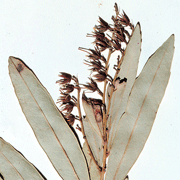James L. Luteyn and Paola Pedraza-Peñalosa
The New York Botanical Garden
|
|
Pieris D. Don (Ericaceae, Vaccinioideae,
Andromedeae) comprises seven allopatric and rather distinctive species
occurring in E Asia
(Nepal across China and Japan to Kamchatka Peninsula and Commander Islands),
E North America (Appalachians from Virginia and West Virginia south to
N Georgia; Coastal Plain from southern South Carolina to N Florida and
west to Mississippi), and West Indies (W Cuba, Isle of Pines). The
only species in the Neotropics is Pieris cubensis. The genus is most closely related to Lyonia, Agarista, and Craibiodendron (see Stevens, 1971; Judd, 1979,
1982). It has often been confused with Lyonia, and sometimes has
been split into several genera (see discussion in Judd, 1979, 1981, 1982).
However, Pieris is here considered to be a monophyletic group easily
separated from related genera by a number of characters including leaf
arrangement and anatomy, timing of inflorescence development, filament
and spur morphology, and fruit and seed morphology (Judd, 1982).
Judd (1979, 1982) conducted a cladistic analysis of Pieris and related
genera, addressing the question of generic circumscription, and recognized
the genus as distinct from Lyonia. |
PIERIS D. Don, Edinburgh New Philos. J. 17: 159. 1834. Andromeda Linnaeus sect. Pieris (D. Don) A. Gray, Man. Bot.
No. U.S. ed. 2. 254. 1856. Lyonia Nuttall sect. Pieris (D. Don) K. Koch, Dendrol. 2: 116. 1872. Andromeda Linnaeus subgen.
Pieris (D. Don) A. Gray, Synopt. Fl. N. Amer. 2: 32. 1878. Type: Pieris formosa (Wallich) D. Don.
For full synonomy, see Judd (1995).
Evergreen shrubs (rarely trees or woody
vines), occasionally spreading by means of horizontal underground rhizomes,
with terete or angled branches and usually gray, longitudinally furrowed
bark; indumentum of unicellular hairs, multicellular, biseriate-stalked
hairs with small glandular heads, (and sometimes multicellular, multiseriate,
long-celled hairs); buds with (2 or) 3 or 4 (rarely to 6) imbricate
scales. Leaves alternate (rarely pseudoverticillate or in whorls
of 3), scalelike at base of innovation, coriaceous, sparsely covered with
multicellular, biseriate-stalked, gland-headed hairs on both surfaces,
with unicellular hairs on midvein of adaxial surface; margin entire, obscurely
to clearly toothed, (or rarely serrulate); venation brochidodromous
(to rarely reticulodromous), with midvein prominent and tertiary veins
reticulate. Inflorescences produced the year preceding flowering,
axillary (or rarely terminal), racemose (or rarely paniculate]); pedicels
with 1 small bract at base and 2 lateral, alternate to subopposite bracteoles
near base to near apex. Flowers perfect, usually fragrant, pendulous,
5-merous; calyx valvate, articulated with pedicel, persistent (or
less commonly deciduous) in fruit; corolla (urceolate to) cylindrical-urceolate
(sometimes strongly ridged and with conspicuous pouches between calyx lobes),white,
with short, imbricate lobes, (usually) glabrous on both adaxial and abaxial
surfaces; stamens 10 in 2 whorls, included; filaments flattened,
strongly expanded near base, straight or geniculate, (smooth, papillose,
or) with long to short unicellular hairs, with a pair of stout, minutely
papillose, spurlike appendages at anther-filament junction; anthers
± ovoid, obscurely (to clearly) papillose, lacking apical awns,
dehiscing by large, introrse-terminal, elliptic pores, (usually) with line
of white disintegration tissue on back of each lobe but not extending into
spurs; pollen tricolporate, in tetrads, without viscin strands; ovary
glabrous to sparsely (or densely) covered with unicellular hairs, with
placentae axile, slightly bilobed, bearing numerous anatropous ovules;
nectariferous disc an enlargement of base of ovary wall; style
columnar, slightly swollen near base, straight, (slightly to) strongly
impressed into apex of ovary and placentae appearing (subapical to) nearly
basal with respect to apex of capsule, as long as corolla; stigma truncate
to capitate, obscurely 5-lobed, minutely papillose. Capsules, erect,
glabrous to unicellular-pubescent, with unthickened sutures; placentae
persistent on columella; seeds small, brown, (spindle-shaped to)
angular-ovoid, (occasionally slightly winged,) end sometimes truncated,
the loose, thin testa composed of a single layer of (elongated or) ±
isodiametric cells (in surface view).
Key to Neotropical Species Back to Top
This is a version of the taxonomic treatment of the neotropical species of Pieris by Walter S. Judd, modified from "Ericaceae--Part II. The Superior-Ovaried Genera (Monotropoideae, Pyroloideae, Rhododendroideae, and Vaccinioideae p.p.)." The full treatment including specimen citations may be see in Flora Neotropica Monograph 66: 345-350 (Judd, 1995d). This on-line synthesis is published with permission of The New York Botanical Garden and Walter S. Judd.
